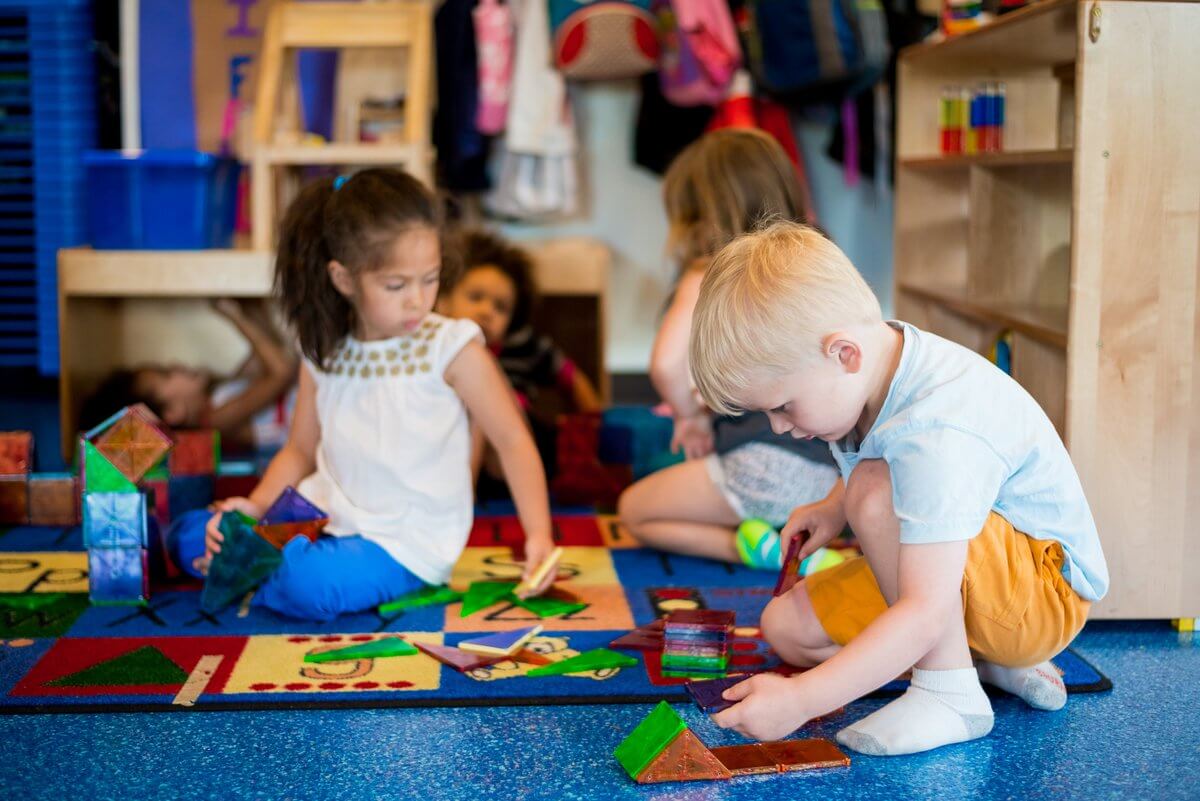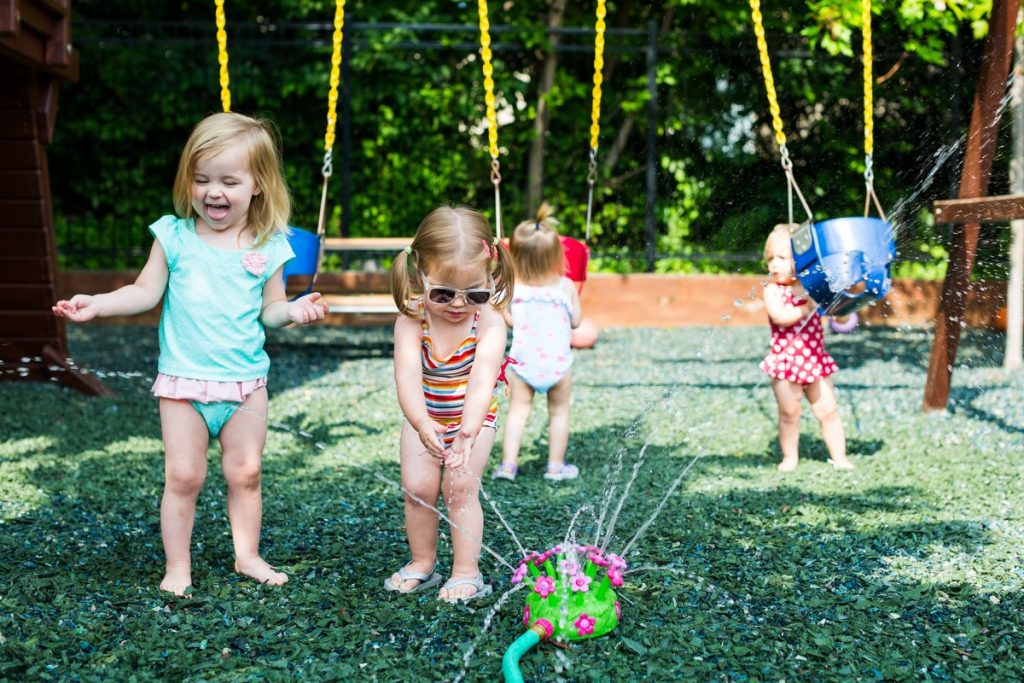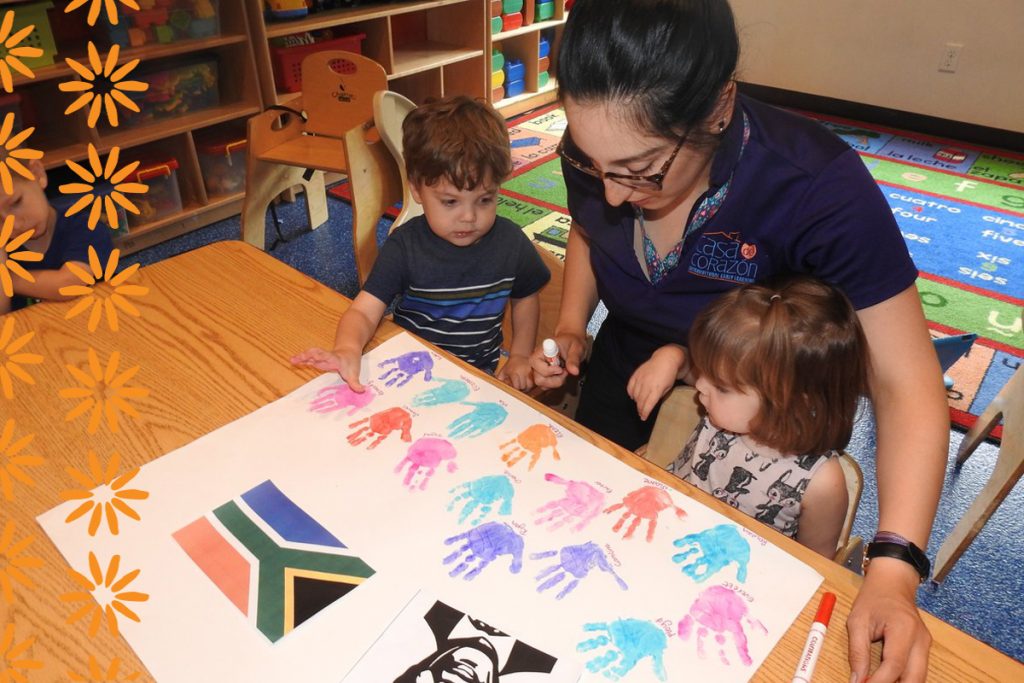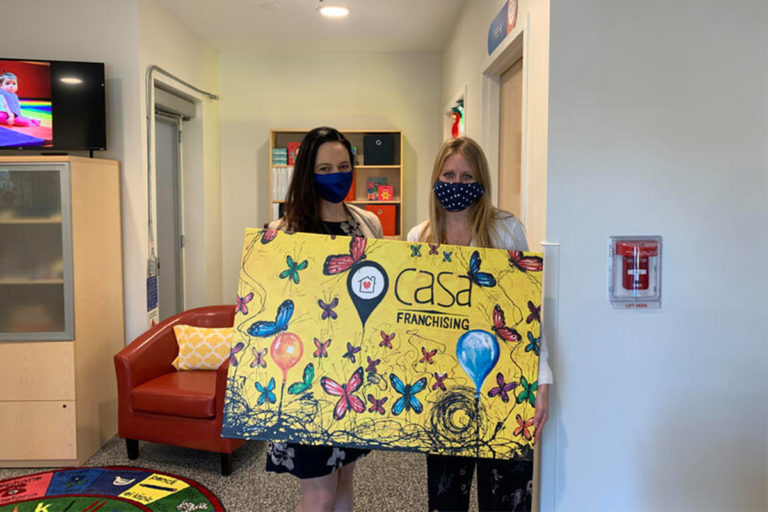The Benefits of Play-Based Learning in Early Childhood Education

Play-based learning is a child-centered approach that uses play as the foundation for exploring ideas, building skills and making sense of the world. It’s often guided by educators or caregivers, but led by children’s natural curiosity and creativity.
In this article, we’ll break down how the benefits of play-based learning, how it helps children thrive—and how parents and programs like Casa de Corazón can support this joyful, hands-on approach to early childhood education.
What is Play-Based Learning?
Play-based learning is an early childhood education approach that lets kids learn through meaningful, hands-on play. Instead of memorizing facts or sitting through lessons, children explore new ideas in creative ways—by building, imagining, pretending and experimenting. This style of learning centers around a child’s natural curiosity and supports their growth in a fun, flexible environment.
Unlike more traditional learning methods, play-based learning focuses less on worksheets and more on experiences. Children lead the way, and adults support their growth by asking questions, providing materials or joining the play when needed.
Types of Play in Play-Based Learning
There are many ways children learn through play. Here are a few common types and examples:
Free Play: Child-initiated play with no set goals or rules. Kids make all the decisions and use their imagination freely.
Example: Pretending to be doctors or building a castle with blocks.
Guided Play: The child leads, but an adult helps guide learning with questions or materials.
Example: A teacher asking, “What happens if you add another block here?” during block play.
Structured Play: Adult-planned activities with a learning goal, but still fun and playful.
Example: A sorting game using colored buttons to teach early math skills.
Games with Rules: Play that follows agreed-upon rules, helping children practice patience, teamwork and decision-making.
Example: Playing “Duck, Duck, Goose” or simple board games like “Candy Land.”
Experiential Play (Hands-On Learning): Kids learn by doing—interacting with real objects, nature or sensory materials.
Example: Planting seeds to learn how plants grow.
Each of these types of play helps children build important life skills in ways that are developmentally appropriate, joyful and engaging.
Why is Play-Based Learning Important?
Play-based learning is especially important during early childhood, when children’s brains are growing quickly. They’re learning to speak, move, think and connect with others. These early years—typically before age seven—are a key time for developing language, social skills, emotional regulation and creativity.
No matter a child’s age, play helps reinforce learning in a meaningful way. It turns lessons into experiences—and those experiences into lasting knowledge. Here are just a few reasons why play-based learning is critical for a child’s development:
1. Encourages Exploration, Risk-taking and Experimentation
Play-based learning gives children the freedom to take risks. Instead of focusing on getting the “right” answer, children explore and learn by doing. This kind of learning supports important thinking skills—like asking “what if” and “why”—which help children grow into confident, flexible problem-solvers.
Some examples of activities that support experimentation and risk-taking include:
Sinking & Floating Water Play: Children experiment with water and objects to see what sinks or floats, building early science skills like cause-and-effect, sorting, and prediction.
Building Towers with Blocks: Balancing, stacking, and rebuilding helps children learn about structure, gravity, and persistence. Each fall becomes a new challenge to solve.

When children explore freely, they build confidence. They learn that it’s okay to struggle with a challenge and try again. This kind of independent thinking supports self-direction and helps kids take ownership of their learning. These early experiences shape lifelong habits like persistence, curiosity and adaptability—skills that help children succeed in school and in life.
2. Hones Physical Development
Through active, hands-on play, kids develop both fine motor skills (small, precise movements like grasping and writing) and gross motor skills (larger movements like running, balancing and jumping).
Here are some examples of activities that support physical growth:
Obstacle Courses for Crawling, Balancing and Jumping: Letting children move through simple obstacle courses challenges their coordination and builds awareness of space and movement—all while having fun.
Throwing and Catching Games with Soft Balls or Bean Bags: These games develop hand-eye coordination, reaction time and upper-body strength. They also help children practice teamwork and focus.
Beyond strength and coordination, physical play helps children build a positive relationship with movement. When children see active play as fun and rewarding, they’re more likely to enjoy exercise and physical activity as they grow. These early experiences support long-term health, well-being and confidence in their bodies.
3. Encourages Independence
Play-based learning puts children in charge of their own ideas. Instead of being told exactly what to do, they get to make choices, solve problems and explore their interests. This sense of control helps boost confidence.
Some examples of activities that support independence include:
Open-Ended Art Projects (like collage-making or free drawing): Children choose their materials, set their own goals and decide how to express themselves—all without step-by-step instructions.
Pretend Play / Role-Playing (like playing “store,” “doctor,” or “house”): In dramatic play, kids create their own stories, manage rules and take on responsibilities.
By giving children time and space to explore independently, play-based learning supports not just school readiness—but real-world readiness, too.
4. Adds Joy to Learning
When children learn through play, they feel connected, excited and curious. Play-based learning brings joy into the learning process, helping children form positive emotional connections with education from an early age. Instead of feeling pressure to perform, kids feel free to discover—making learning more meaningful and fun.
One approach that blends learning and fun is called edutainment—education + entertainment. It includes creative activities like songs, games, storytelling, puppets and videos that engage children while teaching important skills. Because it blends learning with fun, edutainment keeps children focused and helps them absorb new information in a memorable, enjoyable way.
The joy children feel through playful learning doesn’t stop in childhood. It helps them:
- Develop into self-motivated learners
- Approach new challenges with a positive attitude
- Stay resilient when things don’t go as planned
5. Promotes Creativity and Imaginative Thinking
Children are naturally creative, and play-based learning gives them the space to explore that creativity freely. With no set instructions or expected outcomes, children can imagine new worlds, tell stories and express ideas in unique ways. This kind of open-ended play encourages them to come up with their own solutions to problems. Some examples of activities that spark imagination include:
Painting, Drawing and Open-Ended Art: With tools like crayons, paint and clay, kids can express themselves through color, shapes and texture. Artistic play supports storytelling and emotional expression—even without words.
Building or Constructive Play (like forts or LEGO creations): Children design and build their own spaces or inventions, using their imagination to create something completely new. This type of play also supports thinking in 3D and planning.

In the long term, imaginative thinkers are often better problem-solvers and more confident decision-makers. Creative play also supports emotional growth and prepares children for future learning in school and beyond—especially in careers that value innovation, design or strategy.
6. Develops Language and Communication
Play-based learning is one of the best ways for children to grow their communication and language skills. Whether they’re acting out a story, singing a song, or playing a game with friends, children are constantly building their vocabulary, sentence structure, listening skills and even nonverbal communication—all in a natural and interactive way.
Here are some examples of activities that help build language skills:
Storytelling with Puppets or Toys: By creating and telling stories using figures or stuffed animals, children practice sequencing, expressive language and problem-solving. It’s also a great way for them to build confidence while speaking aloud.
Singing Songs, Rhymes and Movement Games: Repetition in songs helps children learn new words, improve pronunciation and identify patterns in language. Music and movement also support social engagement and build listening skills.
Play isn’t just about words—it’s multimodal. Children also use facial expressions, tone of voice, body language and gestures to communicate. Activities like charades, nursery rhymes, and action songs allow children to play with sounds and movement, helping them express themselves even before they can speak fluently.
7. Creates a Culture of Collaboration
Many of the most important life skills, like teamwork, start with play. Play-based learning naturally encourages collaboration, as children often work together, share materials, take on different roles and figure things out as a team. Unlike individual or strictly teacher-led activities, play opens the door for real conversations and shared experiences between children.
Some activities that encourage teamwork include:
Building Projects with Blocks or Loose Parts (like creating a city together): Children brainstorm together, plan their designs, and take on different responsibilities—setting the foundation for group problem-solving and cooperation.
Cooperative Games (like “parachute play,” “Simon Says,” or scavenger hunts): These group activities require coordination and communication. Everyone works together to complete the task, turning movement into meaningful teamwork.
Creating a culture of collaboration prepares children for future success, where teamwork and inclusive thinking are essential.
8. Develops Social and Emotional Skills
Learning how to understand and manage emotions is just as important as learning letters and numbers—especially in early childhood. Play-based learning supports social and emotional development by giving children natural, low-pressure opportunities to practice self-control, communication and conflict resolution. Through cooperative games, storytelling and pretend play, children begin to recognize their own feelings and better understand the emotions of others.
Some activities that support social-emotional growth include:
Sharing and Turn-Based Games: Activities that involve taking turns, like passing a ball or waiting for a turn with a toy, teach fairness, cooperation and patience.
Emotion-Themed Activities: Reading storybooks about feelings, using puppets to act out expressions, or playing “emotion charades” helps children learn to name, understand and respond to emotions—their own and others’.
By allowing children to work through feelings and social situations in playful settings, we help them build the tools they need to thrive—today and in the future.
9. Improves Bilingualism
Play-based learning is one of the most effective ways to help children learn language—including a second language like Spanish. Because play is interactive, exciting and filled with real-life context, it creates natural opportunities for children to hear, practice and understand new words and phrases. Through songs, stories and pretend play, kids begin to use both languages with confidence.
Being bilingual in early childhood offers many lifelong benefits. It enhances cognitive flexibility, problem-solving skills and executive functioning—all key to school readiness and long-term success. Children who learn Spanish at a young age also build stronger fluency and a more native-like accent, thanks to the brain’s early receptiveness to sounds and language structures.
Here are a few examples of language-based activities:
Role-playing Activities (like “playing market” in Spanish): Kids practice real vocabulary in context—like naming foods, asking questions, or using polite phrases—while having fun in pretend scenarios.
Singing Bilingual Songs and Rhymes: Catchy tunes and repeating patterns help build vocabulary, improve pronunciation and make learning both languages feel joyful and natural.
Whether your child is hearing Spanish at home or at school, playful learning helps make it stick.
Learn more: How to Practice Spanish at Home With Your Child and Spanish Alphabet Activities
How to Implement Play-Based Learning
Play-based learning can be part of everyday life. Whether you’re a parent at home or an educator in a center, here are some simple and creative ways to support this joyful, hands-on approach to learning:
Create Open-Ended Play Spaces: Use items like blocks, craft supplies, dress-up clothes or sensory bins that let kids explore and invent freely.
Encourage Pretend Play: Join your child in make-believe games—or let them lead the story using toys, costumes, or even everyday household items.
Incorporate Play into Daily Routines: Turn errands and chores into learning opportunities—like counting apples at the store, singing during cleanup or coming up with silly stories at bath time.
Use Songs, Rhymes and Fingerplays: Music and movement are powerful tools for building language, memory, motor skills and emotional connections.
Choose Games That Involve Strategy: Simple board games, memory games, or building challenges promote thinking, patience and collaboration.
In high-quality early childhood programs, like Casa de Corazón, play is a core part of the curriculum. Whether it’s used for building language skills, exploring cultural themes or practicing social-emotional growth, play invites children to engage with learning in a joyful and natural way.
To make play truly meaningful for children, families and educators should be active supporters and facilitators of the process:
Intentional Planning and Goal Setting: Even child-led play needs thoughtful preparation. Adults can provide materials and prompts that match developmental goals.
Flexibility and Observation: Let the child lead. Observe their play to see what they’re curious about, then use that as a guide for introducing new ideas.
Consistency at Home and School: Repeating songs, routines, or games children know from school at home helps strengthen skills and build deeper understanding.
Responsive, Caring Interaction: Play becomes even more powerful when adults are engaged, ask questions, show interest and celebrate children’s ideas—without taking over.
By creating a supportive environment and being active yet gentle guides, parents and teachers can help children get the most out of learning through play—setting the stage for confidence, curiosity and lifelong learning.
Enrich Your Child’s Development with Play-Based Learning
Enrichment programs offer children experiences that go beyond the typical preschool classroom. By incorporating play-based learning, these programs become even more impactful—helping children grow academically, socially, emotionally and physically in ways that feel meaningful and fun.
At Casa de Corazón, our enrichment programs are designed to do exactly that. Through Spanish immersion, cultural exploration, social-emotional learning and creative play, our education model helps children thrive in a bilingual, inclusive environment. We offer enrichment opportunities for children ages 6 weeks to 5 years, supporting development during the most important years of growth.
If you live in Minnesota or Wisconsin and want to give your child the benefits of play-based, immersive education, we invite you to explore our programs and schedule a tour today:



